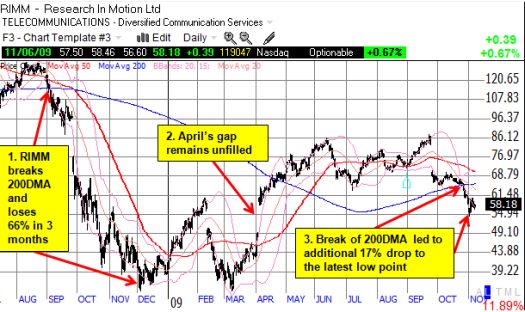On November 5, Research In Motion (RIMM) announced a buyback of up to $1.2B in shares starting November 9 and lasting for up to a year. When I read this announcement, I pounced on the stock the minute pre-market trading opened. This was quite a mental exercise for me because I had just closed out the last of my puts on RIMM the prior week. However, given that part of my rationale was that RIMM appeared over-extended on the downside, I figured that positive news like this could pop the “over-stretched rubber band” back to the upside. Much to my disappointment, RIMM opened for trading at my purchase price and within 45 minutes printed a fresh low on the day. That move punted me from the position with a very small loss. Two days and counting, the response to RIMM’s buyback announcement remains relatively tepid. It is as if the market is skeptical that RIMM’s share repurchases will amount to much. After reviewing RIMM’s balance sheet, I became skeptical of RIMM’s ability to spend the full $1.2B allocated for the buyback.
A quick review of RIMM’s balance sheet (data from Gridstone Research, Inc.) shows as of the quarter ending August, 2009, RIMM had $1.1B in cash and equivalents and $581M in short-term investments. Cash is down 5% both from the previous quarter and year-over-year. Short-term investments are down 6% from the previous quarter but up 38% year-over-year. Total current assets are $5.2B (total current assets include things like inventory and receivables), total current liabilities are $2.2B, and RIMM has no long-term debt. RIMM’s buyback would consume all of its existing cash or 71% of its total liquid holdings. I find it hard to believe that RIMM would execute such a large drawdown of its stash of cash in just 12 months in a slow growth economy that remains borderline recessionary; the company lost cash in the past year, and boosting cash levels may prove extremely difficult in the coming year. Granted, with cash earning next to nothing these days, management need only believe in modest appreciation of the company’s shares to justify a massive repurchase program.
Cisco (CSCO) provides a great contrast. On November 4, CSCO’s board of directors authorized up to $10 billion in additional repurchases of its common stock with no fixed date for termination, bringing the total authorization up to $13.1B. CSCO’s balance sheet is flush with liquidity: $4.8B in cash and cash equivalents, $30.6B in short-term investments. Total current assets are worth $44.7B. While RIMM’s buyback consumes the majority of its liquid assets, CSCO’s buyback consumes about 37% of its liquid assets. I have very little trouble believing CSCO can handle its announced buyback under the current economic conditions.
My note of caution comes from watching Joy Global (JOYG) back away from its buyback program in March as its already limited cash and liquid holdings dwindled further into the depth of the recession. In September, 2008, JOYG boosted a $1B buyback to $2B with just $307M in cash in hand.
A TheStreet.com article “Not Every Share-Buyback Shows Confidence” also strikes a chord of caution when it comes to announced buybacks. The author reminds us that attempts to boost a company’s stock price through buybacks also benefits employees who hold stock as part of their compensation – management typically holds the vast majority of those shares.
In RIMM’s case, stock-based compensation has increased over the years: $38.1M at the end of fiscal year ending Feb, 2009, up from $33.7M the prior year. Stock options are detailed in the annual report. The last report was for 2008. Options outstanding dropped from 9.1M to 7.3M from March, 2007 to March, 2008. The annual report also states “as of March 1, 2008, there was $133.6 million of unrecognized stock-based compensation expense related to unvested stock options which will be expensed over the vesting period, which, on a weighted-average basis, results in a period of approximately 2.5 years.” That end-period just happens to coincide with the expiration of RIMM’s announced buyback. If this is more than just a huge coincidence, it at least shows that RIMM is highly motivated to execute this buyback – even if it cannot deliver the full $1.2B.
RIMM’s management is surely motivated to take action given the continued bleeding in the stock since its September earnings report which sent the stock down 17% in one day. From a technical standpoint, last week’s plunge below the 200 day-moving average threw up a huge red flag (see chart below). A similar breakdown last occurred September 3, 2008. Three months later, RIMM lost 66% of its value (of course, the entire stock market crumbled in that period). If RIMM’s buyback fails to prop up the stock in the short-term, there is very little price support until April’s up-gap is filled around $49. (Click here for a more detailed technical analysis of RIMM from ino.com.).

*Chart created using TeleChart:

Be careful out there!
Full disclosure: no positions.

Point of clarification: I purposely excluded long-term investments in this analysis. These are *typically* not considered liquid investments although they can be allocated (in advance) for repurchasing shares. The dividing line between short and long-term investment can be considered an accounting convention, but I would throw up a red flag if a company drained even its LT money on purchasing its own shares. This article explains LT investments on the balance sheet: http://beginnersinvest.about.com/od/analyzingabalancesheet/a/long-term-investments.htm